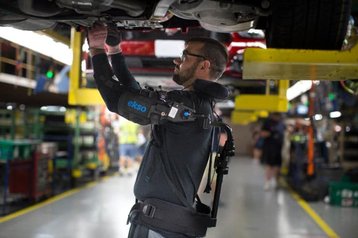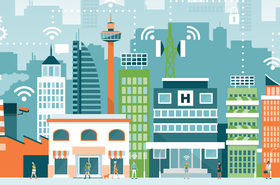With 2019 drawing to a close as inevitable as an impeachment inquiry, enterprises around the world are trying to figure out what edge computing is, where it is, and how they can get some of it. Meanwhile, more enlightened enterprises are finalizing their multi-cloud strategies for 2020 and optimizing them for cost and performance. We are all still waiting for 5G to arrive and the accompanying deluge of IoT data that will come with it.
Cyber insurance brokers are all busy writing policies for the companies that don’t have them and upgrading the policies of those that do. Sadly, 2019 is the year that subscriptions to Lifelock (a US identity theft protection service) became stocking stuffers. And I am wondering why on earth I decided not predict that data center power densities would rise, when after several years of beating my head against that wall (see #7 here), they finally did!
Did the construction labor shortage force data center innovation? Did digital transformation turn IT into a profit center? Did private cloud take back spend from public cloud? Well, my machine learning algorithm’s performance is somewhat less than impressive (operator error), and my grades are a mixed bag. Without further ado, I give you the report card for my 2019 Top 8 Data Center and Tech Predictions.
1: Construction labor shortage will force data center innovation
Grade: A
2019 was a great year for investment in construction tech with loads of money pouring into the sector. With hyperscale data center operators spending $31B in capex in the 3rd quarter of this year alone, innovation is necessary to keep up with the breakneck pace that will be required to meet their increasing needs.
Leading construction firms are investigating, piloting, and implementing a wide myriad of technologies. Although some are not yet ready for prime time, investments into robotic process automation and exoskeletons are starting to yield results. Other technologies like drones, wearables, and laser scanning are more mature and are becoming more wide spread in adoption.
Construction is a little late to the big data party, yet the industry is increasingly becoming more data driven, which will create more opportunities for the implementation of AI. This technology is also helping attract a younger workforce to the industry.
2: Connectivity becomes even more critical
Grade: B
With public and private cloud adoption on the rise, and geographically dispersed workloads becoming the norm, I didn’t go too far out on a limb with this prediction. That said, I think the issue will escalate when edge and 5G enable new technologies, so I marked myself down a little here. With $3M payouts going to 16 year-olds for a hard day’s work at the Fortnite World Cup, can you possibly underestimate the value of a really fast connection?
3: Digital transformation will turn IT into a profit center
Grade: D+
I don’t have any data to back this up either way, but from my view, there are still far too many digital laggards out there to give myself anything above a mediocre grade. I see more industries fully leveraging IT for increased productivity and better user experience, and I also see a lot of the old status quo. Unfortunately, FUD (fear, uncertainty, doubt) is still a clear and present danger while navigating the waters of digital transformation. Digital transformation is not a one-time project, rather a continuous improvement strategy where there is no finish line. I maintain one thing from my prediction, there has never been a better time to be a geek!
4: Data breaches will happen more frequently and get larger
Grade: B
Sadly, 2019 looks to be a record year for data breaches. There were 3,800 publicly disclosed breaches and 4.1 billion records exposed in the first half of the year alone for a 54 percent increase over the first half of 2018. I was wrong on the breaches getting larger, but how can you top the banner year the hackers had in 2018? If my crystal ball was really working, I would have predicted something related to the massive increase in ransomware attacks this year.
5: Private cloud takes back spend from public cloud
Grade: A
This is a tough one to grade as the only public data I can find is related to hardware sales to enterprises for private cloud and hyperscalers/cloud operators for public cloud. That data shows public cloud infrastructure sales fell by 15.1 percent in Q2 while sales of private cloud infrastructure rose slightly by 0.7 percent. Two trusted experts I asked thought hybrid is on the rise as part of market maturity, which makes great sense. I have heard many differing opinions on this topic. As my wife says, “don’t bring opinion to a data fight”, and the data says I was right.
6: Public cloud will continue to drive wholesale colocation
Grade: B
Leasing by hyperscale operators drove record wholesale colocation leasing in 2018. Nowhere was this more apparent than in Northern Virginia where 270 MW of wholesale colocation was absorbed. Although that number is projected by some to be down significantly this year to around 140 MW, that is still the 2nd highest rate of absorption on record thanks to the hyperscalers. I ding myself slightly due to Q2 success being attributed to enterprise leasing by a couple of the major wholesale providers.
7: Colocation will enable hybrid IT
Grade: A
This prediction ties in with both #5 and #6 above. There has absolutely been a move toward hybrid IT, not only to place applications where they perform best, but also to optimize cost. Colocation is also the best way for enterprises to directly access cloud on-ramps to improve performance. Colocation is the perfect meeting point to leverage both public and private cloud.
8: 5G will change our lives, just not in 2019
Grade: A+
In the US, AT&T turned on what they called 5G in December of 2018 in 12 cities. When it did go live, the only device that could connect to it was a 5G hotspot. Verizon’s much ballyhooed launch of 5G occurred in certain areas of two cities, Chicago and Minneapolis, on April 3. The key part of that sentence is “certain areas.” Given that I lived in a suburb of Minneapolis until very recently, it did not change my life, or any others that did not live within the few square blocks downtown where 5G was initially installed.
Until late this year, there were only a scant few 5G phones on the market. Combine that with the line of sight limitations of the technology and 5G was much ado about nothing in 2019. Yes, we must crawl before we walk and run, making this a good and necessary step to take. But let’s not make it out to be something it’s not: life changing – at least not yet. Critics believe that it will never scale beyond dense urban areas due to the technologies’ limitations. One thing is sure, with the massive number of installations that must occur to expand the coverage area, it won’t be widespread anytime soon.
How did I do?
These grades are substantially better than my grades in college, and probably the best since I’ve been sharing my predictions and opinions. This could be a case of the inmates running the asylum given that I am grading my own work. I am interested in hearing how you think I did with my predictions. Please give me a shout in the comments section below, or on LinkedIn or Twitter.
Stay tuned to Datacenter Dynamics for my 2020 divinations.





